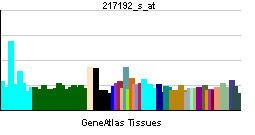Entrez 639 | Ensembl ENSG00000057657 | |
 | ||
Aliases PRDM1, BLIMP1, PRDI-BF1, PR domain 1 External IDs MGI: 99655 HomoloGene: 925 GeneCards: PRDM1 | ||
PR domain zinc finger protein 1 also known as BLIMP-1 is a protein that in humans is encoded by the PRDM1 gene. BLIMP-1 acts as a repressor of beta-interferon (β-IFN) gene expression. The protein binds specifically to the PRDI (positive regulatory domain I element) of the β-IFN gene promoter. Transcription of this gene increases upon virus induction.
Contents
Function
The increased expression of the Blimp-1 protein in B lymphocytes, T lymphocytes, NK cell and other immune system cells leads to an immune response through proliferation and differentiation of antibody secreting plasma cells. Blimp-1 is also considered a 'master regulator' of hematopoietic stem cells.
Blimp1 (also known as Prdm1), a known transcriptional repressor, has a critical role in the foundation of the mouse germ cell lineage, as its disruption causes a block early in the process of primordial germ cell formation. Blimp1-deficient mutant embryos form a tight cluster of about 20 primordial germ cell-like cells, which fail to show the characteristic migration, proliferation and consistent repression of homeobox genes that normally accompany specification of primordial germ cells. The genetic lineage-tracing experiments indicate that the Blimp1-positive cells originating from the proximal posterior epiblast cells are indeed the lineage-restricted primordial germ cell precursors.
Second cancers after radiation treatment
A genome-wide association study has identified two genetic variations near the PRDM1 gene that predict an increased likelihood of developing a second cancer after radiation treatment for Hodgkin lymphoma.
